Home
A comprehensive resource for safe and responsible laser use
US: Student lands safely despite windscreen blocked by oil
A substance appearing to be oil coated the Cessna 172’s windscreen. The unnamed student said “I literally can’t see a thing” to flight controllers who safely talked him down. The incident lasted about 7 1/2 minutes.
Air traffic controller Tim Martin, who helped the student, said “That’s probably like a worst-case scenario for that pilot to land that plane with zero visibility.”
A spokesperson at at the student’s school, Embry Riddle Aeronautical University, said “the student-pilot did exactly what he had been trained to do.”
From the Daytona Beach News-Journal. Although this incident does not involve a laser, it does involve a pilot with no forward vision undertaking a landing, and thus may be relevant to pilots who are temporarily blinded by a dazzling laser beam exposure.
US and Iran: UPDATED - Iranian naval ship shines laser on US helicopter says U.S.; Iran denies
A group of three U.S. ships — a destroyer, an amphibious assault ship, and a dry cargo ship — were transiting international waters in the Strait of Hormuz, according to a U.S. military statement. The Iranian naval vessel, said by one source to be a missile ship, came within 800 yards of the assault ship and scanned two of the U.S. ships with a spotlight.
The helicopter was flying alongside the deployment when the Iranian targeting laser was aimed at it, setting off the flares.
There was no report of injury to the helicopter pilots. A spokesperson for the U.S. Navy’s Fifth Fleet said “Illuminating helicopters with lasers at night is dangerous as it creates a navigational hazard that can impair vision and can be disorienting to pilots using night vision goggles.”
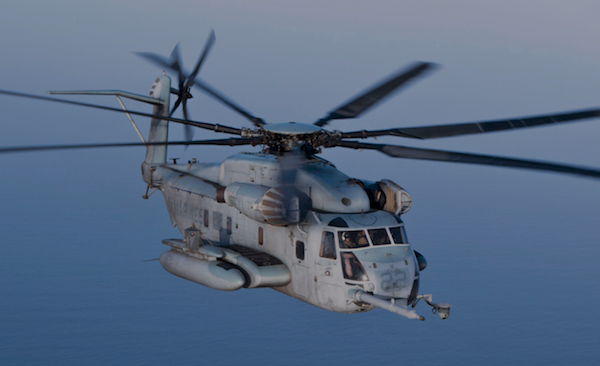
Marine Corps Sikorsky CH-53E Super Stallion
From Newsweek and CNN
UPDATED JULY 16 2017 - Iran claimed it did not point a laser at the helicopter. The Tasnim News Agency said “A top commander of Iran’s Navy denied reports that the country’s naval forces had pointed a laser at an airborne US Marine Corps helicopter in the Strait of Hormuz back in June. Commander of Iran's First Naval Zone Admiral Hossein Azad categorically denied reports of such incident.”
The report had no additional details, such as what could have set off the helicopter’s flares as claimed by the initial U.S. report.
From the Tasnim News Agency and the Tehran Times
UK: (Not a laser) Drone slices toddler's eye in half
The accident happened in mid-October, in Stouerport, North Westchestershire. Simon Evans, next door neighbor to the family, had prior experience operating drones. Oscar was in his family’s front yard when after about 60 seconds of flight, Evans’ drone hit a tree, went out of control, and sliced through the toddler’s eye. The BBC quoted his mother, Amy Roberts, as saying “What I saw was what I thought was the bottom half of his eye, and it's the worst thing I've ever seen."
From the Telegraph and Ars Technica
Analysis and commentary from LaserPointerSafety.com
Although this severe accident did not involve lasers, there are some comparisons and contrasts with consumer laser pointer eye injuries. In almost all cases, a consumer laser injury does not cause complete loss of vision. It certainly does not result in exterior damage or destruction of the entire eyeball. On the other hand, drone injuries are rare, with only a few cases of persons being injured by falling drones. This is the only drone eye injury we are aware of, while there are a number of laser pointer eye injuries, some of which are in lists here and here.
US: (Not a laser) Distraction from selfies and maybe camera flash likely cause of fatal crash, NTSB says
Widely reported in the press was the fact that the cell phone camera’s flash function was used during an earlier portion of the flight. (The aircraft made one 6-minute flight around the traffic pattern, landed, took off again, made a left turn, stalled and spiraled into the ground.) As recorded by a second camera, a GoPro, during the 6-minute flight, the cameraphone flash was used “during the takeoff roll, initial climb, and flight in the traffic pattern.”
The NTSB did not state whether the use of the camera flash impeded the pilot’s vision. He was able to successfully complete the first, 6-minute flight despite being flashed multiple times. It was on the second takeoff that the pilot stalled, leading to the spin into terrain.
Click to read more...
US, Canada: Aircraft have close calls with drone UAVs (not a laser incident)
- In Vancouver, the pilot of a K.D. Air Corporation airplane reported a near-miss with a UAV when taking off from Vancouver International Airport. Investigators were searching to find the person responsible. A Royal Canadian Mounted Police spokesperson said this was not the first case, and they have investigated several complaints of model aircraft flying near the airport. According to the Vancouver Sun, he also said that “lasers pointed at police helicopters and other aircraft are equally troubling and there are few regulations prohibiting the use of either device in such situations.”
- In New York City, a UAV described as a “drone” flying near the George Washington Bridge came within 800 feet of a police helicopter. The UAV was at about 2,000 feet altitude, which is above the 400 foot limit set by the Federal Aviation Administration for model aircraft used for recreation. The helicopter pilot was able to track the drone as it landed. Officers on the ground arrested Wilkins Mendoza, 34, and Remy Castro, 23, and charged them with reckless endangerment.
From the Vancouver Sun (drone only story; drone + laser story) and the New York Times
US: Jurors find spotlight misuser guilty on one charge, not guilty on another
On April 28 2011 the jury found Wayne P. Groen, 42, guilty of incapacitation of an individual during authorized operation of an aircraft. The jury found him not guilty of interfering with the authorized operation of an aircraft. Sentencing was set for August 4 2011.
Groen lives near Lynden, Washington about 1/2 mile south of the U.S.-Canada border. According to the Seattle Times, Groen said he aimed the spotlight at the Border Protection helicopter because he was “curious” about their activities, bothered by the noise, and “wanted to alert the pilots as to how close they were to his home.”
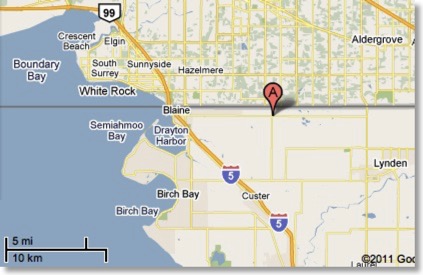
Groen lives on H Street Road, which parallels the U.S.-Canada border
The Bellingham Herald reports that some of Groen’s neighbors have been annoyed by Border Protection activities, such as frequent low-level helicopter flights and vehicles traveling through their yards and fields. They “have been tempted” to spotlight helicopters, and felt that threat of a long prison term (up to 40 years) for Groen was excessive. One man quoted by the paper said he was in an old barn at night when a helicopter hovered overhead and the metal roof began to rattle and shake: “Had I had a good flashlight I would have shined it up at that black object to see what it was.”
From the Seattle Times and the Bellingham Herald. An account of the opening day of the trial, entitled “Light v. helicopter -- who felt threatened most?” can be read after registering at the Lynden Tribune; a cached version is available at Google.
UPDATE August 4 2011: Wayne Groen was sentenced to two months in prison, 90 days of home detention, 120 hours of community service, three years of community supervision, and a $5,000 fine for incapacitating an individual during the authorized operation of an aircraft. Groen could have received up to 20 years in prison. The prosecution recommended 10 months; the defense wanted no prison time, one year of probation, 120 hours of community service and a $5,000 fine. From The News Tribune
US: Dallas spotlight illuminates jet on final approach
The club said the light was “installed at an angle” which they were told would not be a problem for aircraft. An FAA official said that incidents like this had the potential to cause a problem such as the co-pilot having to complete a landing.
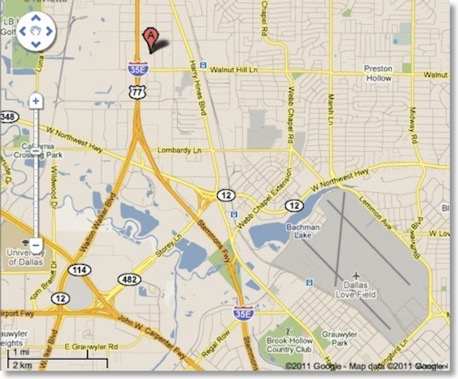
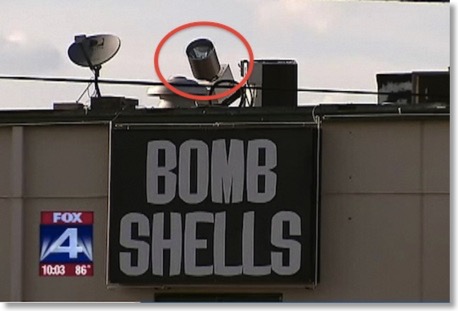
Location of the spotlight on the Bombshells roof. Video still from KDFW Fox 4.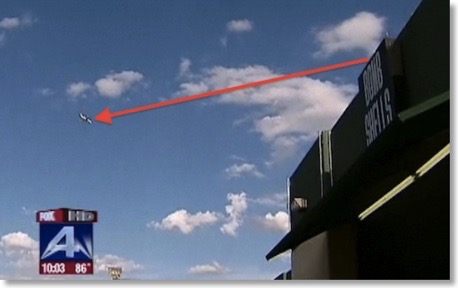
Location of Bombshells, relative to the Dallas Love Field approach. Arrow points to a passing jet. Video still from KDFW Fox 4.
From KDFW Fox 4, Dallas-Fort Worth. Feb. 2011 note: The club may have changed its name since the incident, to “Dallas Cabaret”.
UK: 63-year-old arrested for aiming flashlight (torch)
Merriott said the gunships sounded like an "earthquake" and were "10 feet above my garden" in his farmhouse near Eye, Suffolk. News reports said he used the flashlight to identify the aircraft, during the September 18 2009 incident.
The flashlight was readily available and cost £8.45 (US $13.86). Merriott owns a theatrical lighting firm that has lit flying helicopters at a Buckingham Palace event. He insists he did not put the aircraft at risk: "Don't tell the Taliban that all they need is an eight-quid torch to bring down multi-million-pound high-tech gunships."
Full story, with photo of Merriott and a torch, from the Daily Mail.
UPDATE: Charges were dropped two days after the incident. Merriott said he was considering making an official complaint:
"I cannot help feeling that to keep me locked up for nine hours is pretty vindictive, when I was happy to make a statement. It was heavy handed and I think they were trying to teach me a lesson."
Update from EDP24